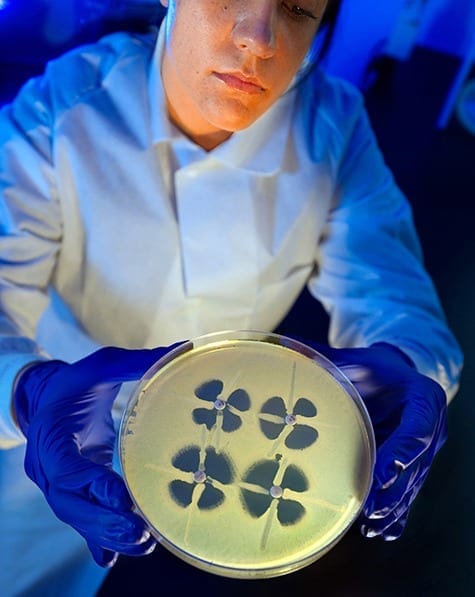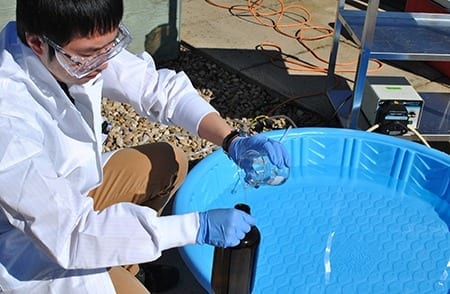
Pharmaceutical industry has withdrawn from the ‘antibiotic space.’ Is it time for research universities to step in?
The Centers for Disease Control and Prevention has said that at least 2 million Americans are sickened by antibiotic resistant infections each year and survive. (Twenty-three thousand die.) These experiences leave deep impressions not just on the patients but on their family and friends.
Michael Kinch, PhD, associate vice chancellor and director of the Center for Research Innovation in Business, is among that number. A few years ago his 12-year-old son suddenly became ill, so ill Kinch had to carry him into a nearby clinic in his arms. Because his son had a fever, the doctors at the clinic put him on first one and then a second antibiotic while they worked on a diagnosis.
They soon learned his son’s appendix had burst and he was septic. “Things moved so fast he was septic before he was symptomatic [for appendicitis],” Kinch said. His son was moved to an academic medical center where he had surgery and was put on four newer antibiotics.
When the lab tests for antibiotic susceptibility finally came in, they showed the pathogenic bacteria were susceptible to only two of the six antibiotics Kinch’s son had been given. Stunningly, the two that worked were the older drugs he had been given at the clinic. “I can only assume that if we had gone straight to the academic medical center, he might not have survived,” Kinch said.
“It’s not that my son had had extensive exposure to antibiotics,” Kinch explained carefully. “We’re all just colonized by resistant bacteria now.”
“Three weeks later I was asked to join a nonprofit organization working on new models for drug development, called the Institute for Life Sciences Collaboration,” Kinch said. “The institute was picking the therapeutic areas that would be their focus. “They were considering various exotic diseases, and I said, ‘Antibiotics.’”
Antibiotics are crashing.
The Latest on: Antibiotics
[google_news title=”” keyword=”Antibiotics” num_posts=”10″ blurb_length=”0″ show_thumb=”left”]
via Google News
The Latest on: Antibiotics
- Systemic antibiotics in first year of life tied to higher atopic dermatitis riskon May 8, 2024 at 11:03 am
Systemic antibiotic exposure in the first year of life is associated with higher atopic dermatitis (AD) risk in a dose-response fashion, according to a study published online April 24 in the Journal ...
- Pensioner died after hospital failed to administer antibiotics in timeon May 8, 2024 at 4:00 am
A pensioner died after a delay in administering antibiotics, a coroner has concluded. Eleanor Smith died after a week-long stay in hospital, following breaking her hip from a fall using her walker.
- Study highlights overuse of antibiotics in newborns with suspected sepsison May 7, 2024 at 6:56 am
Newborns in Sweden are given antibiotics for suspected sepsis to an unjustified extent. This is according to a study by the University of Gothenburg in more than 1 million newborns. Despite a ...
- Synthetic Antibiotics Could Improve Treatment of “Superbugs”on May 7, 2024 at 6:21 am
Technology Networks spoke to Dr. Ishwar Singh to learn more about the challenges of drug-resistant infections, the discovery of teixobactin and the benefits of synthetic antibodies.
- I was a fit and healthy teenager but ended up in a wheelchair after taking antibiotics – I may never walk properly againon May 6, 2024 at 11:39 pm
TIA LAZZERI-MADDEN was a fit, healthy teenager, a musician with her whole life ahead of her. But a rare condition has left Tia, 18, having to use a wheelchair. She began to experience some side ...
- Can a personalized antibiotics, prebiotics, and probiotics combo help treat IBS?on May 4, 2024 at 11:00 pm
A pilot study suggests that a personalized combination of antibiotics, prebiotics, and probiotics may help treat the symptoms of post-infectious irritable bowel syndrome (IBS).
- WHO alarmed by high use of antibiotics in COVID-19 caseson May 2, 2024 at 10:44 pm
New evidence from the World Health Organization (WHO) has shown that the extensive use of antibiotics during the coronavirus pandemic may have worsened the “silent” ...
- Chick-fil-A changes to chicken with antibioticson May 2, 2024 at 10:29 am
Chick-fil-A changed their chicken supply from chicken with no antibiotics (NAE) to chicken with No Antibiotics Important to Human Medicine (NAIHM) earlier this spring, meaning more of the company's fo ...
- ‘Just in case’ antibiotics widely overused during COVID-19, says UN health agencyon April 29, 2024 at 1:30 am
At no point during the global pandemic did the UN health agency recommend using antibiotics to treat COVID-19, insisted WHO spokesperson Dr. Margaret Harris.
- No Antibiotics Needed – Revolutionary Chronic Wound Treatment Could Help Millionson April 28, 2024 at 1:29 am
An international team of scientists has developed a new treatment for chronic wounds that uses ionized gas to activate a wound dressing, without the need for antibiotics. The treatment involves the pl ...
via Bing News










